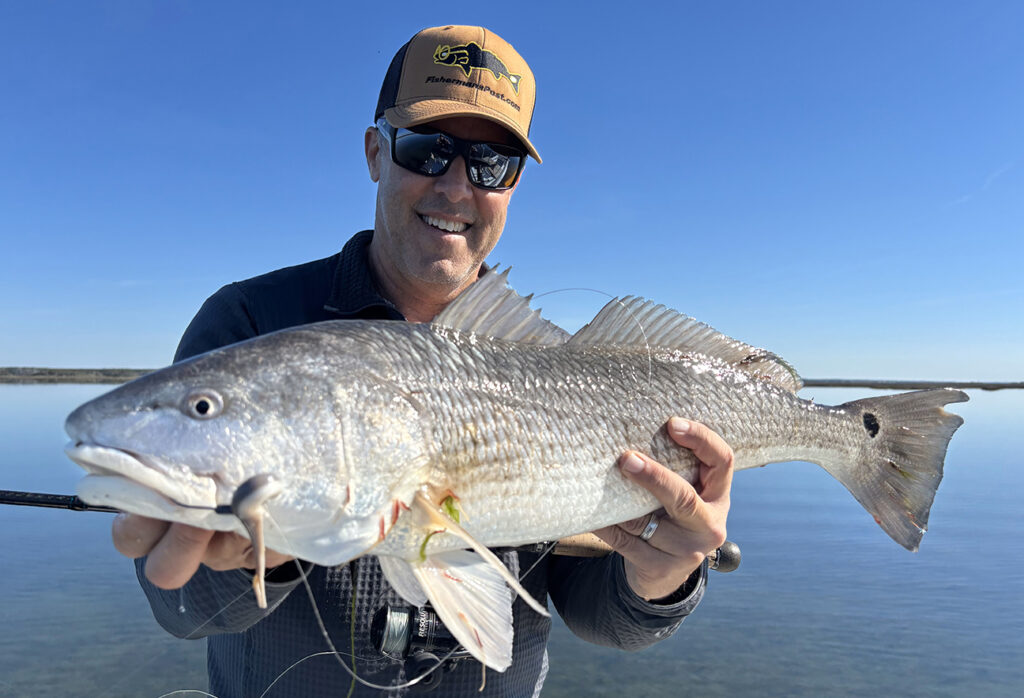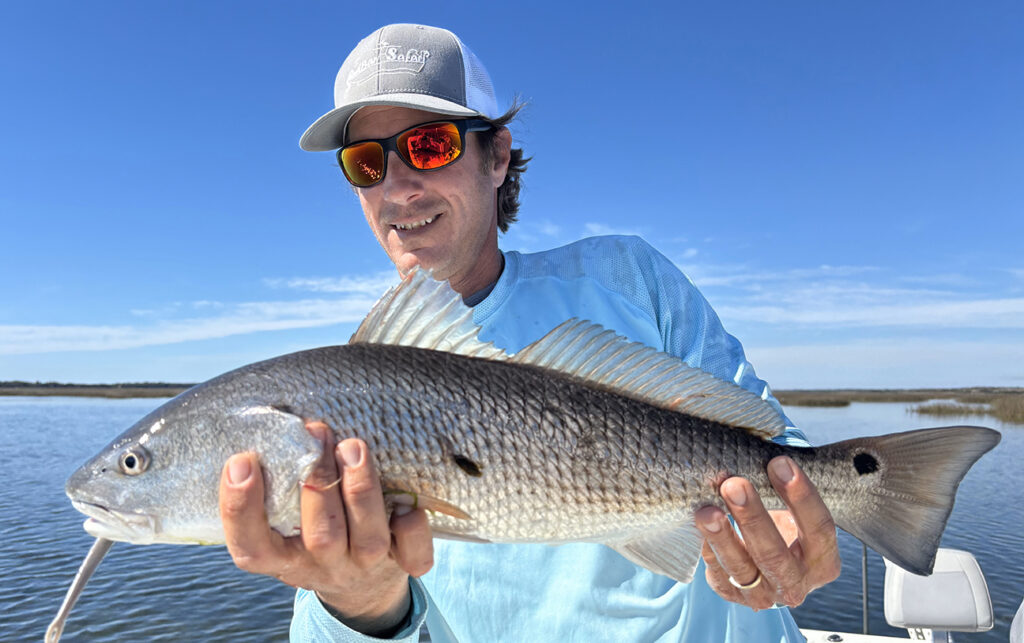Tidelines – April 2025
“What is Gary Hurley going to tell Rob Koraly about a red drum?” I asked out loud to Rob, mocking myself as the over-slot redfish I had hooked while sight fishing in a Swansboro marsh came beside the boat.
I had met Capt. Rob Koraly, of Sandbar Safari Fishing and Eco Tours, at Dudley’s Marina in Swansboro around 9:00 am, and it was a perfect March morning: clear skies and a cool air temperature expected to heat up nicely by midday, but even better was the zero wind as we pulled away from the docks. The bright sun and stillness of the morning meant that our visibility for sight fishing red drum in the still “gin clear” water would be optimal.
Though the majority of the water was anywhere from 1-3 feet deep, Rob maneuvered into the wide-open marsh on plane and began immediately with his reconnaissance work by doing a quick loop through one of the coves. We kept about 25 feet or so from the bank, and about half way through the semicircle, Rob saw what he was looking for.
“There’s about 30-40 fish that just got up and pushed some water as we went by,” Rob explained. “If we don’t find the bigger school I’m expecting in the back of the bay, then we can come back here and target these fish.”
Without slowing down, we headed into the next cove, and Rob did the same quick pass by. This time, though, no fish moved.
“We just saved ourselves about an hour,” Rob told me as we headed back out into the larger body of water. “It would have taken us about an hour to cover that bank by casting, but we found out in less than one minute that there aren’t any fish there to target.”
Rob’s friend Jake had done his own searching earlier that morning and had texted Rob about a bigger school of reds in the way back. Knowing there were fish, Rob didn’t do a pass by but slowed the boat well shy of the first grass bank he wanted to check out.
Rob had me get up on top of the platform he mounts to the front of the boat for trips such as this, and he gave me a rod tied with a weedless and weighted Gulp fluke. The weight allows for a long cast, the weedless helps keep the snot moss off, the scent is to help create interest, and the forked tail visually resembles the stuff they’re eating off the bottom. Rob told me to be as quiet as possible because these fish have been pressured all winter, and then he grabbed his Push Pole.
The first bank we targeted was quiet, no fish home, but while covering that area, Rob noticed water movement on the next bank over. Fortunately, the tide was at our back, so we slowly drifted towards what we could now see was a big school of redfish sometimes separating and sometimes joining as they moved around in a large area of water defined on one side by a grass bank and on the other by a shallow flat they didn’t want to cross.

Gary Hurley, of Fisherman’s Post, with an over-slot red drum that fell for a Gulp fluke sitting still on the bottom in 2′ of water. He was fishing with Capt. Rob Koraly of Sandbar Safari Fishing and Eco Tours.
Our slow drift gave Rob plenty of time to pattern the fish, and soon he used the Stick-It Pin to hold us in place close enough to reach the school as they made their laps, but far enough away so that we wouldn’t be noticed.
“I try to put my boat where they can’t go or where they don’t want to go,” he shared. “I’m not going to be in the way of where they want to go back and forth. If you run them out of a place, they just won’t come back.”
As the school came within reach, I put a cast well out in front, and Rob told me to just let my bait sit without any movement. I kinda listened, but only kinda, as I couldn’t help but give the soft plastic a slow retrieve. The big school passed over my lure with no interest.
As I reeled in, Rob explained why he wanted me to just let my bait sit completely still, “There’s nothing else swimming in the water, no mullet, no menhaden, no finfish of any kind, and the reds are slurping stuff off the bottom, such as sand worms, eels, and all kinds of little life. It’s not stuff that’s up in the water column swimming around, so if they see something swimming through the middle of the water column, it actually surprises them and spooks them a little bit.”
The majority of the school was now over by the far grass bank, so Rob had me cast back out to the open water where my artificial had just been. This time I listened when he told me to just let it sit.
The school made their way back, and this time after about a third of the school had passed by, my line came tight and I was fast to an upper-slot red drum that went on several good runs before Rob collected the fish for photos.

Capt. Rob Koraly, of Sandbar Safari Fishing and Eco Tours, with a red drum that he hooked sight casting a soft plastic to a school of approximatley 100 fish in a shallow bay west of Swansboro.
Trying to get a finicky red drum to bite is something Rob has thought about often, “If you have your lure laying on the bottom and they start to swim over it, all it takes is for one of those fish to brush it with their tail and move it a little bit, and the other one behind him just smacks it.”
I put another cast out in roughly the same space where I had just been bit. Once again I listened to Rob and just let my Gulp fluke sit, and once again a section of the school swam past my lure before a second red drum picked it up.
From a distance, Rob identified this second fish as a bigger red drum. I saw the fish as basically the same size, but of course, when the fish came boat side, it was clearly an over-slot fish with much bigger shoulders than the first.
The bigger fish coming over the gunnel was when I asked out loud, “What is Gary Hurley going to tell Rob Koraly about a red drum?” I should have listened to Rob the first time he told me to let my soft plastic sit still on the bottom, and I certainly shouldn’t have second guessed him on the size of a fish.
Capt. Rob Koraly, of Sandbar Safari Fishing and Eco Tours, will be catching red drum, as well as a host of other species that includes black drum, sheepshead, trout, spanish and bonito, cobia, and more in the Swansboro and Emerald Isle area all year long. No matter the season, no matter the conditions, and no matter the fish behavior, you can rest assured that Rob will employ the best strategy to catch fish and make memories.
You can check him out at www.sandbarsafari.com, or call him direct at (252) 725-4614.
And if you want to know, then I’m sure he can tell you something about a red drum…or a sheepshead…or a trout…or a bonito…or a cobia. The trick isn’t to get him to share knowledge or advice, as he’s happy to help. The trick, or at least the trick for me, is simply to listen.
